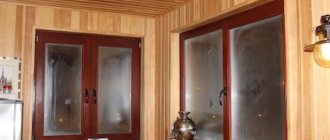It is promoted by an increased percentage of humidity and low internal air temperature in the room.
When certain conditions are reached, condensation drops form en masse on the surface of windows outside, inside or between the glass panes as a result of reaching the saturation temperature. This temperature is also called the “dew point”.
If a prolonged effect of window fogging occurs, the owner of the premises must take effective measures to combat high humidity, since it contributes to the formation of fungus on the surfaces of windows and walls. Mold and bacteria affect human health and sometimes lead to the development of serious illnesses.
What is condensate?
Excessive fogging of windows in a house or apartment is an indicator of the quality of the indoor microclimate. This phenomenon is based on physical processes .
There is water vapor in the indoor air due to human activity or accidents in water supply systems.
When the air temperature reaches the saturation temperature, they turn into liquid and fall out in the form of droplets on cold surfaces.
Windows always act as a boundary between cold street air and warm room air ; sometimes the temperature difference they have to maintain is several tens of degrees. In this case, a zone of cold air is created near them, while excess moisture can no longer be in the air and falls onto the cold surfaces of glass and walls in the form of condensate drops.
Important! With higher humidity, the condensation process can begin at a smaller temperature difference. So, at a maximum humidity percentage of 100%, the “dew point” is already formed when the temperature near the unit indoors decreases by only 1 C.
Should he appear?
The appearance of condensation indicates that the internal microclimate does not meet the regulatory requirements of the SES for humidity and air temperature. This phenomenon always appears on wooden blocks if the apartment or house has insufficient ventilation, high humidity and low-quality heating.
However, the presence of condensation on windows is not always an emergency, for example, if it forms on the outside street side during fog or rain. But if the glass becomes fogged up in dry weather, then this indicates serious violations in the structure of the house , for example, due to improperly installed ebbs or poor waterproofing of installation seams.
How to treat plastic windows to prevent sweating?
Another option for eliminating “crying” windows is their regular treatment.
- Of course, if possible and necessary (if the windows sweat a lot), buy special products that are designed directly to eliminate condensation on the windows. Such products, when applied to windows, create an invisible film that helps repel water. You can buy them in good household chemical stores, and you can also order them from the store where you purchased the windows. Before use, be sure to carefully read the instructions.
- is considered no less effective . To do this, you need to dissolve a tablespoon of salt (without a slide) in 5 liters of water. Filter the solution, thereby removing crystals of undissolved salt. Then wipe the window with the prepared solution. If after this procedure there are streaks or white marks left on the window, dilute the solution with a small amount of water and repeat wiping again.
Treatment of sweaty windows
- You can also use a soap solution. Take some water and add just a little bit of any detergent. Soak a microfiber cloth in the resulting solution, wring it well and wipe the window. Then rinse the window thoroughly with clean water and dry with a dry microfiber cloth.
- A solution of water and alcohol. It is recommended to use this product when the room is quite cold. You need to add very little alcohol. This solution is quite easily applied to glass, while creating good protection against moisture.
Now we propose to move on to folk remedies for eliminating “crying” windows. Agree, we all quite often resort to similar methods of solving problems, so why not use such advice in this situation?
In which areas does it occur most often?
The most common places for dew point to form are the inside of the window, facing the living room or inside the glass unit.
In the first case, this phenomenon is caused by a violation of the thermal regime in the room, below +18 C, and in the second case, due to structural defects in the double-glazed window.
Most often, the thermal conditions in the room are not maintained due to low heat supply, but other reasons also happen, for example, an excessively wide window sill becomes a resistance to normal heating of the block, which is why the “dew point” moves to its inner surface.
Thick curtains can also cover the heat from the radiators.
Causes of condensation
One of the functions of wooden or plastic windows is to protect the room from freezing. However, products do not always fulfill their purpose properly because they are not used correctly. The following are common causes of condensation:
- significant difference in temperatures inside and outside the house;
- increased indoor air humidity;
- the window sill above the radiator is too wide;
- poor ventilation (clogged);
- non-compliance with window operating modes (some double-glazed windows have two modes - winter and summer);
- the room is rarely ventilated (or never);
- the wrong window was selected for a certain room;
- the presence of plants on the windowsills.
There is another group of reasons that contribute to the formation of moisture on glass. We are talking about errors in the production of windows, as well as inaccuracies during the installation of double-glazed windows. These factors will be discussed in more detail below.
Why is this happening?
If we systematize all the sources of dangerous fogging of wooden blocks, then they are grouped by construction projects - a private house or apartment, as well as by the place where the “dew point” occurs: inside the frame and double-glazed window and on the glass from inside the room.
From inside the room
Here, the formation of a “dew point” is the most common phenomenon, the reasons for its appearance are very diverse :
- High humidity in the room (over 50%) with poor ventilation.
As a rule, this phenomenon occurs especially often in the kitchen, bathroom or on a glazed loggia. An effective method of control in this case is to periodically ventilate the premises for at least 15 minutes, checking the ventilation ducts in the house for operability and sufficient air exchange. It may be necessary to clean them of contaminants or expand the channels. - A significant number of flowers are placed on the windowsill; it is better to move them away from the window and deeper into the room, especially since in winter they will be much warmer there.
- Inoperative heating device, low air temperature (below 18 C). In this case, you need to purge the battery of seals and dirt in order to circulate coolant through it, which will lead to increased heat. The recommended room temperature should be +20C.
- Thick curtains on the window become an obstacle to the circulation of warm air from the heating device to it, so the air temperature around it drops to the “dew point” and even lower.
- Resistance to convective heat transfer due to a wide window sill or installed decorative radiator trim.
- Carrying out repair work with a large presence of aqueous solutions: plastering, whitewashing, wallpapering and filling floors with cement mortar.
- Poor thermal protection of the external wall, leaky interpanel seams and the presence of through cracks.
- Incorrect installation of the window unit, large gaps in the technological opening.
Between the glasses
The reasons for the formation of condensation for conventional frames and those with double-glazed windows are different , although the source is the same - the movement of the “dew point” into the space between the glasses.
This occurs at high humidity, which can penetrate into this area both from outside and from the inside.
In this case, warm air from the room either does not enter at all, or enters in a small amount, insufficient to compensate for the natural heat loss of the external load-bearing wall and wooden window block.
For conventional frames, the source of moisture between the windows is poor adhesion of the glass to the wooden parts. This defect occurs quite often, and can be easily eliminated by owners using glazing beads, window putty, sealants and seals.
Note! For double-glazed windows this situation is more dramatic; owners will not be able to fix it on their own.
Reasons for the formation of “dew point” inside glass:
- In 40 - 50% of cases, this is a manufacturing defect due to depressurization of the package during production, storage or transportation. Correction is only possible by installing a new double-glazed window.
- The size of the frame and the glass unit do not match; the window unit must be completely replaced.
- Mechanical damage to the glass unit, violation of its integrity, even if there are no visible cracks, requires its complete replacement.
- Placement of additional accessories, for example, some blinds are installed directly on the frame, due to which the unit is completely depressurized, the window unit will need to be completely replaced.
- Violation of the technology for assembling a wooden block with a double-glazed window, for example, the absence of silica gel between the glasses, due to which moisture is not absorbed, will require a complete replacement of the window block.
- Incorrect technology for installing a wooden window, skewed glass block and depressurization will require a complete replacement.
If condensation forms between the glass of a wooden frame with a double-glazed window, the owner should not seal it himself.
Since the warranty obligations for the window are jointly borne by both the manufacturer and the installer of the unit .
As a rule, such a defect appears during the first heating season, when the warranty is still valid, so if you find foggy glass inside, you should immediately call the installation company.
In apartments
In apartments located in an apartment building, windows fog up most often , which is due to low hydro- and thermal resistance of external walls, poor quality central heating and clogged general building ventilation ducts.
These causes account for 80% of cases of window fogging, so first of all, owners should pay attention to these sources.
In addition, window fogging is affected by:
- Failure to take heat-protective measures on a wooden window block before the start of the heating season.
- Washing and drying clothes in the apartment.
- Long-term use of the stove in the kitchen.
- A large number of flowers in flowerpots.
- A large number of people living in the apartment.
If the process of glass fogging first occurred at the beginning of the heating season, when major work such as replacing heating appliances, thermal insulation of walls and cleaning ventilation ducts cannot be carried out, as a temporary measure of protection, experts recommend periodically ventilating rooms for no more than 15 minutes, installing dehumidifiers and additional heating sources to increase the air temperature to 20 C.
In private homes
Owners of private houses are much less likely to encounter the problem of wet glass ; such cases occur in no more than 20%.
This is explained by the fact that such households have well-insulated walls, reliable autonomous heating, and clean, wide ventilation ducts that are not clogged by neighbors.
Natural ventilation in such houses is much more powerful due to the frequent use of entrance doors and the presence of attic spaces. All this helps remove excess moisture.
The main reasons for condensation on wooden window blocks in private homes may be poor waterproofing of the floor above the basement, which has no ventilation and high humidity, poor thermal insulation of the attic floor, uninsulated walls, poor-quality installation of glass blocks, and malfunctions in the heating systems.
What to do when wooden windows sweat?
If wooden windows fog up, they first need to be sealed.
To do this, all areas where the glass adheres to the wooden frame must be coated with sealant.
In places where wooden frames adjoin each other, it is advisable to use special window seals.
The latter are made from different materials:
- foam rubber is the cheapest, but short-lived sealant;
- rubber – deforms over time and breaks down under the influence of moisture;
- silicone is elastic and durable, but at the same time the most expensive sealant.
If the windows are old and have large gaps in winter, you can use the old folk method of sealing and insulating - sealing them with paper or, even simpler, with tape.
What to do when the windows sweat
Is it possible to make it so that it doesn't fog up?
Most sources of fogging in wooden structures can be eliminated independently , except for those that cause internal condensation in the glass unit.
General recommendations for eliminating fogging of windows:
- A wide window sill that interferes with the flow of heat to the window - if the design allows, then it should be reduced in width. It will also be enough to install special grilles to ensure air access to the glass.
- Remove the decorative grille from the battery.
- Install a heat shield behind the battery to increase its efficiency.
- Thick curtains should be drawn apart during the heating season.
- The presence of a large number of flowers on the windows, they need to be moved deeper into the room.
- Install a dehumidifier when the room humidity is above 50%.
- Compact standard wooden frames.
Why do the windows on the balcony sweat?
The reasons for fogging of windows on a balcony are the same as in an apartment.
If the balcony is unheated, condensation most often appears as a result of the low temperature inside it.
Warm, humid air from the room goes out onto the balcony, after which the moisture settles on the cold windows.
If the balcony is insulated and has plastic windows, the formation of condensation on the glass is due to the lack of ventilation.
When you sweat between the windows
Ways to solve
In addition to general recommendations, there are methods for eliminating the causes of condensation on windows, depending on the location of their occurrence: inside or outside the windows, the type of object - a private house or apartment, and the climatic season of the work.
Moisture between glasses
Fogging inside a double-glazed window is the most severe case ; it requires an immediate call to representatives of the service organization that installed the unit to completely replace the window.
It is very important not to delay this decision while the warranty is still valid, otherwise you will need to pay for the new unit and its installation yourself.
If condensation occurs inside the glass of a regular wooden frame, the owner must take the following measures :
- Remove the glazing beads and carefully remove the glass.
- Find the place where the wooden frames are depressurized, clear it and dry the frame well so that the moisture is completely gone. To make this faster, you can use a hairdryer, both regular and construction.
- Next, the wooden parts on which leaks are found are treated with sealant, as well as the junction of the glass.
- The glass is inserted into place, secured, and the joints are treated with sealant.
- Install glazing beads.
- Install the seal on the sashes.
Important! A wooden window after this treatment will not only be dense, but also soundproof, preventing street noise from entering the room.
From inside the room
Since the sources of moisture formation and heat loss in an apartment and a private household are different, different methods will be required to eliminate fogging of glass inside the room.
Basic capital measures to protect windows from internal fogging for an apartment located in a multi-storey building:
Clean or repair ventilation ducts to ensure natural air circulation.- Organize forced exhaust ventilation in the kitchen.
- Insulate the floor or ceiling if it is adjacent to a cold basement or attic.
- Perform external thermal protection of external walls, especially in areas adjacent to technological openings and interpanel seams.
- Perform purging and adjustment of heating systems.
In private homes, sources of moisture formation are poor insulation of external walls, slabs above the basement and attic floors. All of them will need to be insulated from heat loss with the installation of additional layers of hydro- and vapor protection.
If all heat protection measures have been taken in the house, and in winter the heating source cannot provide the required temperature, the boiler will need to be replaced with a more powerful one. Also, at least once every 2 years, you need to flush the in-house heating circuit to increase the rate of circulation and heat transfer of the coolant.
As a result of these measures, the temperature inside the premises will reach the required 20 C, at which it is impossible to form a “dew point”
In winter
If windows first began to lose with the arrival of cold weather, and capital measures cannot be carried out for technical reasons, owners can take temporary protective measures :
- Perform internal insulation of windows in places where cold air enters using improvised means or purchased materials: self-adhesive paper, construction tape, putty, sealant and sealant.
- Ventilate the room several times a day for 15 minutes until the windows become transparent.
- Install an additional heating source to maintain the room temperature at 20 C.
- Install a heat shield between the radiator and the wall under the window opening.
- Install an independent air dryer.
- Avoid creating additional sources of moisture: flowers, kitchen, drying clothes.
How to prevent it?
Like any problem in the home, fogging is easier to prevent than to fix. For this:
- Perform regular window maintenance. Check the condition of the fittings, tighten loose elements, change rubber bands as they wear out.
- Install automatic supply valves or open the shutters more often in micro-ventilation mode.
- Monitor the surface temperature of the radiator. The minimum temperature to avoid condensation is 60C.
- Clear the window sill. The reason why fogging can sometimes occur is indoor plants: high humidity from them is transferred to the glass.
- Replace regular glass with heated glass. For the harshest winters, there are heating double-glazed windows: the operating principle is similar to heating windows in a car.
All of the above methods will only work if 2 simple conditions are met: correct humidity and temperature conditions. Ensure stable operation of the radiator and get rid of excessive moisture in the air - it’s worth checking, maybe these simple steps will help solve the existing problem.
Folk remedies for condensation
Craftsmen have learned to cope with the problem of window fogging, passing from family to family the most effective options for combating this phenomenon :
Installing a small fan in a window, kitchen and bathroom ventilation duct.- Installation of dehumidifiers directly in the window area.
- Installation of chemical dehumidifiers or moisture-absorbing materials on window sills.
- Treatment of glass with a solution of glycerin and alcohol in a ratio of 1:10.
- Treating windows with saline solution.
- Lighting a candle on the windowsill in the morning.
Production and installation of double-glazed windows
Although plastic window installers are professionals, even they make mistakes. Mistakes are also made by residents of premises where structures are being changed. In this case, you also need to know what to do. Why do windows sweat and “cry”? This is due to several reasons:
- Inaccuracies during the design or manufacture of windows.
- Purchasing the wrong glass unit.
- Poor installation.
Poor quality structures need to be corrected or disposed of. Buyers should choose their windows carefully. If the product will be installed inside rooms or on a loggia, you must purchase a two-chamber model. Products with 1 chamber are ideal for a room bordering a glazed loggia (since it does not need additional insulation).
For reasons of economy, many people choose thin glass, but they do not adequately protect from the cold. In addition, condensation will appear on such products. When replacing plastic products with wooden ones, you need to prepare for a change in ventilation mode. PVC is an airtight material that increases humidity inside, and there are cracks in the wood through which air is exchanged.
If you compare a plastic and wooden structure, you can find one difference - the inner glass of the first has a lower temperature, so it condenses faster. Construction errors are as follows:
- Improper foaming of cracks.
- The appearance of a “cold bridge” - the area where plastic or wood adjoins the side of the wall with a negative temperature.
- Blowing of masonry - appears with the destruction of horizontal or vertical seams between bricks.
If you want to purchase a durable product, it is important to control all stages of window installation. Also, you should not buy a wide window sill. These are the main reasons why windows sweat and cry. It is necessary to identify the cause of this phenomenon and eliminate it.
Difficulties and errors in the correction process
In principle, all known options for correcting fogging of wooden window blocks are effective . Technologically, almost all of them can be done by apartment owners, with the exception of defects in glass blocks that require a complete replacement of the window.
If, during protective measures, condensation on the window does not stop, this rather indicates that all sources of increased moisture entering the apartment have not been eliminated.
In this case, you will need to measure the percentage of humidity in the room with a moisture meter; if it exceeds 50%, then look for additional sources of its occurrence. As a temporary measure, we can suggest increasing ventilation in the room and raising the heating temperature.
Eliminating fogging
There are several basic methods to help avoid fogging. Most of them don't even require any special skills or equipment.
Ventilate the room more often
Air humidity can increase due to various reasons: cleaning, cooking, drying clothes, and even due to human breathing. If the ventilation in the room is adequate, then problems with condensation can be avoided by periodically ventilating the room. However, if this has to be done more and more often, then it’s time to check the ventilation ducts and, if necessary, clean them or equip them with fans.
Install the correct double glazed windows
When choosing a double-glazed window, you should pay attention to what climate zone it is designed for. Remember: the wrong choice will result in significantly reduced efficiency
When selecting, take into account the temperature and humidity in the room and the climate. For example, for central Russia, double-glazed windows will be sufficient for frosts of -20 degrees, since more severe cold weather is rare here.
When choosing a double-glazed window, it is necessary to take into account the climate
Improve air circulation
In an attempt to avoid drafts, owners of wooden windows try to caulk and seal all sorts of cracks. Unfortunately, because of this, the air exchange between the house and the street worsens: a barrier stands in the way of drier street air, circulation drops, and all the moisture accumulates in the apartment. As a result, we get not only foggy windows, but also swollen frames, which will be very difficult to open.
You should remove polyurethane foam from such a “sealed” window, starting from the top
It is important to carefully notice changes, if any. If condensation remains, you should continue to remove the seal.
Organize proper heating
There are several key points here. First of all, heating devices should be placed directly under the windows. One of the causes of dew is incorrect installation of radiators or their poor performance. Radiators should be moved under the window - this will simultaneously improve air circulation and help heat the room. Otherwise, there will be stagnation of cold air, and the windows will constantly “cry”. Moreover, in most cases, wooden frames cannot be completely dried unless there is a heat source underneath.
A properly installed radiator improves air circulation in the roomDuring periods of falling room temperature due to heating problems, many people use gas stoves as an additional source of heat. Unfortunately, this option is far from the best, and simply unsafe. During operation, a gas stove pulls oxygen from the air, instead releasing huge amounts of water vapor and carbon dioxide. These combustion products gradually fill the apartment and, of course, raise the overall temperature, but in return they leave fogged windows, and in especially serious cases can negatively affect the owner’s health.
Eliminate other possible factors
Other factors that can cause dew to form on windows include:
Ventilation valves on windows. Special ventilation valves, which some manufacturers install in the upper part of the window, can significantly reduce the likelihood of fogging. The outside air flowing through them will help maintain convection near the inner glass. If absolutely necessary, you can make them yourself.
It is quite possible to install the ventilation valve yourself.
Window sill width. As already mentioned, radiators should be located under the windows, but an excessively wide window sill can negate all their effectiveness. Its width should be such that rising warm air can easily heat the window glass, taking away excess moisture.
Why is it important to get rid of the problem?
The appearance of condensation on windows is not a harmless phenomenon ; despite its widespread occurrence and duration, it leads to the destruction of both wooden frame structures, window sills and nearby property, and creates conditions for the occurrence of illness in the residents.
Consequences if not corrected
Fogged glass is evidence of a violation of the microclimate in the room. In addition to its direct impact on comfort, humid air:
Promotes the growth of fungi and bacteria that cause respiratory problems and allergic reactions in home occupants.- Creates breeding conditions for dust mites, which affect asthma patients.
- Creates a stench in poorly ventilated areas.
- It is a source of destruction of building structures of the house, especially wooden ones.
Exposure to a damp and moldy home environment is hazardous to the health of home occupants . For many of them, contact with mold leads to nasal congestion, wheezing, redness and itching in the eyes and skin.
The consequences are especially severe for asthmatics, who can suffocate in such a room. Excessive fogging of glass can damage a wooden frame in just one season of operation.
Double-glazed windows modes
Why do plastic windows “cry” if the above factors do not exist? All double-glazed windows have 2 operating modes - summer and winter. If you do not switch from one to the other in a timely manner, condensation appears, since the inside is very cool.
Before cold weather (in October or November), it is advisable to switch the product to winter mode. Condensation often appears indoors, where the windows are rarely opened. In this case, ventilation is necessary for at least 15-20 minutes every day. This ensures not only good air circulation, which protects against condensation, but also fresh air, which has a positive effect on breathing.
You can insulate the space around the window. It is advisable to work with drywall. This material has excellent thermal insulation properties. It is necessary to insulate window slopes, the area under the window sill, and the outer wall. The better the quality of plasterboard finishing, the lower the risk of condensation. An increase in temperature in the house leads to insulation of the space near the window. These steps are easy to perform independently.
Useful tips
It is necessary to combat glass fogging already during the installation of the window unit . It is better to entrust the work to specialists who, according to the contract, must install it in such a way that during its service life it does not become a source of “dew point” formation.
The owner must choose a window design that has additional protection from this negative phenomenon, taking into account the actual operating conditions of the unit.
When solving the issue of major renovation of a room with the installation of wooden windows, it is first necessary to bring the entire in-house ventilation and heating system into working condition, and take care of the implementation of energy-efficient internal or external thermal protection of the walls of the premises.
Windows in your apartment fog up: what to do in practice to avoid condensation
The first thing you should do if you decide never to worry about the windows in your apartment sweating in winter and what to do about such a problem is to solve once and for all all problems with ventilation in the room. If the ventilation really works properly, then water is unlikely to accumulate on the glass. Moreover, you probably won’t be able to cope with this without professionals, since you hardly have any knowledge in such a matter. The entire ventilation system of the apartment should be carefully checked and, if necessary, cleaned or even restored.
Helpful advice
If your apartment windows regularly sweat, and especially in the kitchen, you should install a special high-quality hood above the stove, this should help. Moreover, a branded hood can cope with the elimination of up to fifty percent of excess moisture, and this is quite a lot.
In addition, it is worth understanding that the heating system, no matter how high-quality it is, must also be equipped with an air circulation system. That is, air masses must move in a certain order, otherwise unwanted condensation on the glass occurs. You can also purchase air dehumidifiers, which are also available on the market in an assortment, but this does not always help, since we have already found out that the reason does not always lie in high humidity.
Among other things, it is necessary to inspect and maintain structures at least twice a year so that they remain functional.
This is very important, since condensation, as already mentioned, can form where problems of a simple mechanical operational nature have arisen
- Whatever one may say, twice a year, in spring and autumn, you need to adjust the pressure of the sashes. This is very simple, because these modes are already provided by the designers, so it will be enough to install a special pin in the correct position and that’s it, the work is completed.
- Having found out that the main cause of blowing, and as a result, the appearance of droplets on the glass, is a sagging seal, it can be easily replaced. You can read in more detail on how to change the rubber seals on our website; this will help you get the job done quickly and without problems.
- It is also worth regularly monitoring the micro-ventilation of the window itself, that is, cleaning the drainage holes specially designed for this.
It is clear that the glasses themselves can be treated with such a solution, which will prevent them from fogging, but they do not always work. Moreover, it is worth understanding that regular ventilation also significantly helps in eliminating the problem. All these actions must be performed regularly, not forgetting, in order not only to protect yourself from fungus and mold, as well as window deformation, but also to significantly extend their service life, which will at the same time save your budget, because new window systems are far from cheap.
Recommendations for eliminating condensation
It is important to monitor the condition of double-glazed windows by following the rules for stabilizing the microclimate. If you neglect the advice, then even on two-chamber and reliable structures condensation appears in winter and at other times of the year. You need to know not only why plastic windows “cry”. How to deal with this is an important question. The following recommendations should be followed:
- Check ventilation operation regularly.
- Ventilate your home for 10-15 minutes every day.
- Do not choose single-chamber kits for replacement.
- Monitor the thorough foaming of the joint between the frame and the wall and the remaining stages of installation.
- Do not choose wide window sills that cover the radiator.
- If the double-glazed window has several modes, then change them according to the time of year.
- Perform sealing of slopes.
- Maintain normal humidity - 45-60%.
As you can see, glass can sweat for various reasons. By following simple rules, you can get rid of condensation. Then the glass will always be clean and beautiful.
The concept of dew point
Modern individual construction requires the mandatory installation of Euro-windows. After some time, the double-glazed windows begin to fog up, and the question arises why the windows in a private house cry. This usually occurs as the outside temperature decreases. When air containing water vapor comes into contact with a surface at a lower temperature, condensation is formed - moisture in the form of tiny droplets. The latter group and form “tears” on a cold plane.
The coolest surface in the house turns out to be a double-glazed window, hence the expression “crying window”. The temperature at which condensation forms is called the dew point. This is a state of air when it can no longer absorb moisture. The degree of vapor-air environment of 100% humidity coincides with the dew point.
If we assume that the room is +20ºС, then in winter the inside glass will be +3 and tears will start running down it. In severe frosts, the water on the windows turns into ice. The higher the moisture content in the air of a room, the more it will settle on the windows and create an atmosphere of high humidity, harmful to the health of the residents. This circumstance determines the need to eliminate sweating when it occurs constantly.











